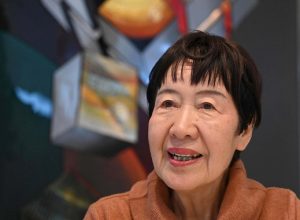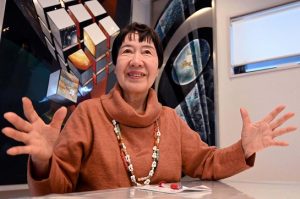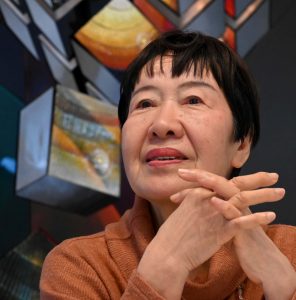Hiroshima Voices: “No Nukes, No War” Toshiko Tanaka, 84, A-bomb survivor and enamel artist, Higashi Ward, Hiroshima
Feb. 23, 2023
Sharing A-bombing experience for victims who died in silence
Inspired by her trip around the world on a cruise ship organized by the NGO Peace Boat, Ms. Tanaka continues to communicate her experience in the atomic bombing at the age of six to audiences in Japan and overseas. While continuing her work as an enamel artist, she recently renovated her home art studio and opened it to the public, conveying her message about the preciousness of life and her wish for the elimination of nuclear weapons to people visiting Hiroshima for reasons of peace education and tourism. About 10 years ago, she visited Russia and Ukraine and interacted with local citizens. Thinking of her friends there, she hopes the war can be halted as soon as possible.
Click here to view the video
I am heartbroken about the reality that the war in Ukraine has continued for this long and claimed the lives of so many people since the start of Russia’s invasion of that country. In 2012, I visited Russia, Ukraine, and Belarus and spoke with victims, as well as their supporters, of the former Soviet Union’s Chernobyl nuclear power plant accident. Ever since the war broke out in Ukraine, I am reminded of the faces of the friends and acquaintances I made in those countries, a recollection that causes me great sorrow.
Looking from space, earth resembles a ship afloat in the sea. Clearly, if war were to happen there, humans would not survive. Furthermore, the possession, threats, and actually use of nuclear weapons are entirely unacceptable. I want to impart to Russian President Vladimir Putin, who has hinted at the possible use of nuclear weapons, to consider global interest, which extends to every individual on earth, rather than merely his country’s national interest. Why do we kill each other simply to expand territory? I hope the non-violent diplomatic efforts taking place in the international community will help bring the war to a quick conclusion.
I was feeling anxious one year ago, so I reached out through an acquaintance to a friend I knew in Kiev and asked if there was anything I could do to help. The message I received back from my friend was that I should continue communicating to the public the horrors that would happen were nuclear weapons ever to be used again.
I experienced the atomic bombing about 2.3 kilometers from the hypocenter in Hiroshima, suffering burns to my arms and head. After the war, I was also crushed by a terrible sense of fatigue. Despite keeping those experiences to myself, I ultimately healed after a long time by reflecting my wishes for peace in my artwork.
My old childhood home, where I had lived until six days before the atomic bombing, was located near the hypocenter. I survived because I had moved away, but many of my friends who remained in that neighborhood died. In some cases, entire families were erased, making it difficult to confirm whether or not anyone had survived. They literally vanished without a trace. Because I knew firsthand the reality of the atomic bombing, I simply found it impossible to communicate my A-bombing experience to others.
Nevertheless, after turning 70, I decided to give it a try. What pushed me to make such a commitment were the words spoken to me by a mayor of a city in the South American nation of Venezuela who I met during the Peace Boat cruise. The mayor told me, “If you don’t speak out as an A-bomb survivor who else will?” I now believe it is my role to convey my experience to memorialize those who died without having the chance to tell their own stories. Each of us must take action to guide the world toward peace. (Interviewed by Hiromi Morita)










